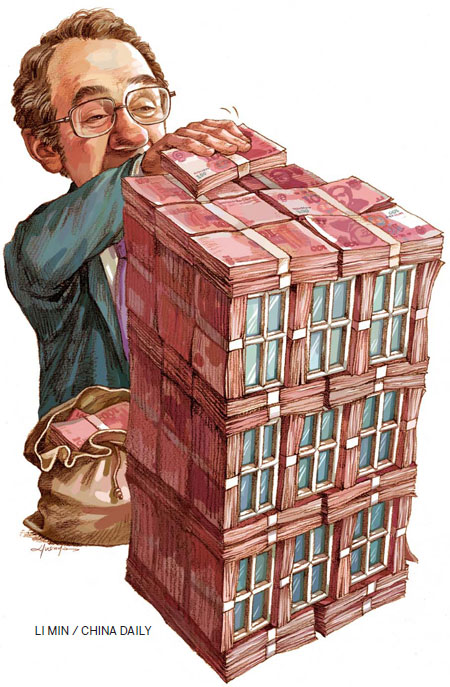Realty check
Updated: 2012-10-19 08:36
By Zhao Yanrong (China Daily)
|
||||||||

Opportune time for foreign investors to stay invested in Chinese real estate despite rough headwinds
When the property market sneezes, everyone catches a cold in China: this is often the catchphrase used by economists to explain the close links the sector has with the Chinese economy.
|
||||
The California Public Employees' Retirement System (CalPERS), the world's largest public pension fund with assets of more than $238 billion (183 billion euros), had said in August that it would invest $530 million in two new real estate funds of the ARA Asset Management for commercial property investments in China, especially office buildings and malls. ARA Asset Management is controlled by billionaire Li Ka-shing.
The property market in China was once described as the "most important sector in the known universe" by Jonathan Anderson, the former chief global emerging markets economist at Swiss bank UBS. His prediction was not far off the mark considering that the fortunes of several bulk commodity industries across the world, particularly the iron, steel and cement sectors, are directly linked to the industry.
In 2011, the total investment in the Chinese property industry jumped by nearly 28 percent over the previous year to 6.17 trillion yuan ($981.6 billion; 765.7 billion euros), according to data provided by the National Bureau of Statistics. That amount is more than four times the total foreign direct investment in the United States of $227.9 billion in the same year.
Such is the importance of the real estate sector in the Chinese economy that its share in the overall GDP had more than tripled to 6 percent from a decade ago, according to information provided by the NBS.
Though the industry growth has been phenomenal in the last few years, it went through a turbulent phase recently as demand flagged and prices remained static.
Testing times
But the recent predicament of the real estate industry is quite different from the situation in 2007 when realty prices across all major Chinese cities slumped by more than 30 percent. Demand was at rock bottom and new projects scarce.
Transaction volumes had recovered in most of the major Chinese cities by the end of 2008, says the 2008 annual report of CBRE Group Inc, the largest commercial real estate services firm in the world.
In late 2008, the industry got a fillip after the government announced a massive 4-trillion-yuan stimulus package to boost domestic spending. Housing was a major part of the stimulus agenda and there was a flurry of activity in the sector in the form of new projects and land deals.
The breakneck speed and the prices at which property was flying off the shelf did trigger some concerns that the sector was overheating. These fears were not unfounded, when reports of vacant or under-performing commercial and residential projects started doing the rounds.
Bubble concerns deepened in 2011 after reports that new home prices had reached unsustainable levels. Matters were also compounded by talks of an impending mortgage crisis due to payment defaults.
In 2011, China was expected to contribute more than 20 percent of the global economic growth. So when property concerns surfaced, it became a major global concern, so much so that "Whether China can find its way out of the biggest housing bubble ever created" was listed as one of the most important economic issues along with the collapse of the euro and the probability of US heading into a double-dip recession.

 Relief reaches isolated village
Relief reaches isolated village
 Rainfall poses new threats to quake-hit region
Rainfall poses new threats to quake-hit region
 Funerals begin for Boston bombing victims
Funerals begin for Boston bombing victims
 Quake takeaway from China's Air Force
Quake takeaway from China's Air Force
 Obama celebrates young inventors at science fair
Obama celebrates young inventors at science fair
 Earth Day marked around the world
Earth Day marked around the world
 Volunteer team helping students find sense of normalcy
Volunteer team helping students find sense of normalcy
 Ethnic groups quick to join rescue efforts
Ethnic groups quick to join rescue efforts
Most Viewed
Editor's Picks

|

|

|

|

|

|
Today's Top News
Chinese fleet drives out Japan's boats from Diaoyu
Health new priority for quake zone
Inspired by Guan, more Chinese pick up golf
Russia criticizes US reports on human rights
China, ROK criticize visits to shrine
Sino-US shared interests emphasized
China 'aims to share its dream with world'
Chinese president appoints 5 new ambassadors
US Weekly

|

|










